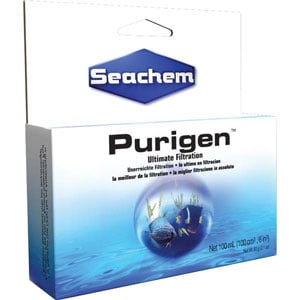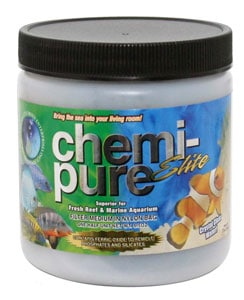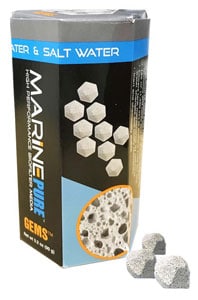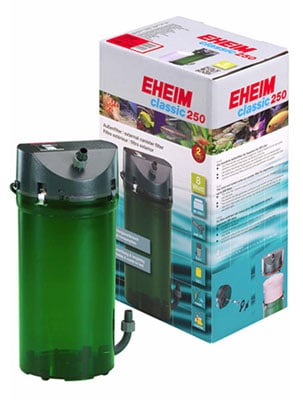A canister is the ‘Go-To’ filter in the freshwater world but as many aquarists move over to a saltwater aquarium one of the first questions they have is if they can reuse their existing equipment – The canister filter being one of them.
Canister filters can be used on a saltwater aquarium as the main filter or a supplemental filter that is used when required. They can provide mechanical, biological, and chemical filtration but must be cleaned regularly to prevent the build-up of detritus leading to high nitrate and ammonia.
So the short answer is Yes, but there are better alternatives available. The main reason why people use a canister filter on their new saltwater aquarium could be for the following reasons:-
- They had one from their previous freshwater setup
- They are a cheaper filter to buy
- Many first saltwater tanks are not drilled for a drain to a sump
- They are usually stocked at many local fish stores and can be easily pushed onto an unsuspecting buyer
In this article I want to show you the pros, cons, and alternatives…
How Does a Canister Filter Work?
Aquarium canister filters work by sucking in aquarium water through an intake pipe placed in the aquarium. The water is then pumped through several containers of various filter media before being returned back to the aquarium via an outlet nozzle or a spray bar consisting of a line of drilled holes.
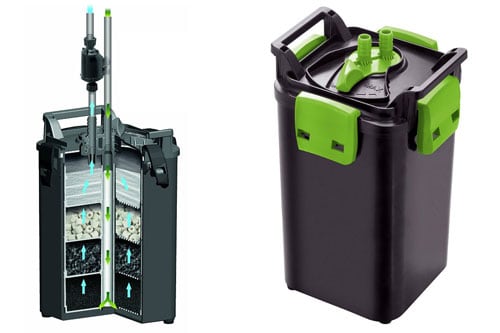
The nice feature that appeals to many aquarists is the main filter body (The Canister) sits outside of the aquarium so it can be easily hidden in the aquarium stand for example. Flexible hoses are then run to and from the aquarium allowing for a very discreet installation.
The modular design of the media containers allows the user to house 3-4 different types of filter media to mechanically, biologically, and chemically filter the water.
The filter can be filled with just one media and used as required or can be filled with multiple media and run as the main water filter for the aquarium.
What Saltwater Media Can You Use In A Canister Filter?
Canister filters are designed to run a combination of mechanical filtration in the form of floss or sponges, chemical filtration in the form of bags of activated carbon, and biological filtration in the form of ceramic tubes to produce a large surface area for nitrifying bacteria to colonize.
When a canister filter is used on a saltwater setup careful selection of media and the order in which it is stacked in the canister will allow you to successfully run a canister filter on smaller aquariums.
The two main problems with the canister filter are that you are usually unable to clearly see what is going on in the filter, and their size limits the amount of filter media you can place in each canister.
To successfully filter a saltwater aquarium you need 3 types of filtration in your system:-
- Mechanical Filtration
- Biological Filtration
- Chemical Filtration
To find out lots more information on each of these types of filtration,
I have a great article all about it called:
‘Types of Aquarium Filter Media & What They Do‘.
The main types of filtration you can easily accomplish with a canister filter on a saltwater aquarium is Mechanical Filtration & Chemical filtration.
The Live Rock/Dry Rock you have in your aquarium will eventually take care of the Biological Filtration as your aquarium cycles and matures so leaving that part out of the canister allows you to either:
- Purchase a smaller and cheaper canister filter, or
- have more room for adding more mechanical & chemical media
NOTE: When using a canister filter you have to establish which way the water flows through the filter to ensure the mechanical media is placed first to remove all the solids to prevent the solids from collecting and plugging the chemical and biological media containers.
What Type of Mechanical Filtration Media to Use in a Canister Filter?
Sponges and filter floss are the best way to accomplish the mechanical removal of solid matter from your water. Most canisters come with purposely shaped pads to perfectly fit inside. They can be regularly rinsed under the tap and replacements are available for purchase as they wear out.
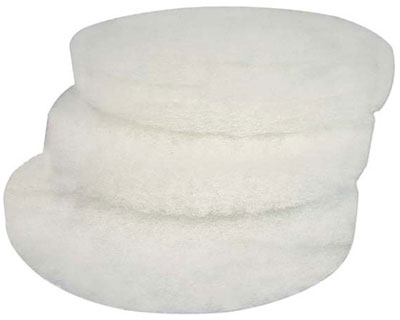
Filter floss in a chamber is a cheaper way to filter out the solids. You can just remove it and replace with new floss each week and a bag of aquarium floss lasts so much longer for a lower purchase cost.
You Can Find aquarium Filter Floss Here at Amazon.com
What Type of Chemical Filtration Media to Use In A Canister Filter?
Activated Carbon is the most common chemical filter media used in canister filters however, products like Purigen and Chemi-Pure combine activated carbon with other chemical media to filter more pollutants from the water by using just one product. They are popular in both fresh and saltwater aquariums.
This is where you can really improve the efficiency of a canister filter with ease because of some great products that are available. Most seasoned canister users will place the following two products into the two chambers following the filter floss:
1. Purigen
This is a synthetic filter media that is designed to absorb Ammonia, Nitrite, and Nitrate compounds. It also has the added benefit of polishing the water, similar to what Activated Carbon does.
As the Purigen becomes exhausted it changes its color to dark blue and eventually black. The great benefit of this product is that you can recharge the media by removing it and washing it in a bleach and water solution.
The recommended usage is 1ml for every gallon
Find Purigen HERE at Amazon.com
2. Chemi-Pure
This is a manufactured mix of Activated Carbon and a ‘Purigen’ type of ion-removing compound that helps to remove organic waste and absorb the harmful Ammonia, Nitrate, and Nitrate compounds. It comes in a bag which can be placed in a media container and will have to be disposed of once it is exhausted.
The manufacturer recommends you change this out every 4-6 months providing you have sized the amount of Chemi-Pure correctly. Once your aquarium begins to get cloudy, it’s time to change the media.
You can now also get Chemi-Pure Elite which adds a Ferric Oxide material to the media to help reduce Phosphates and Silicates at the same time, but only lasts 4 months.
The recommended usage is 1 unit for every 5 – 40 gallons
Find Chemi-Pure HERE at Amazon.com
What Type of Biological Filtration Media to Use In A Canister Filter?
Most aquarists recommend you add in a manufactured ceramic filter media to provide a large surface area for nitrifying bacteria to colonize. The most popular product is MarinePure by CerMedia as it is manufactured with one of the highest surface areas for its size providing maximum colonizing space.
I highly recommend you add in a little of this media to help significantly with Biological Filtration. I mentioned that your rock will be your main biological filter, but if you have space left in your canister of wish to replace the supplied ceramic media with something better then I highly recommend MarinePure Biofilter Gems!
MarinePure is a manufactured form of biological filter media. They are available in ‘Blocks, Plates, Spheres, and smaller ‘Gems’. These are being installed in many aquarium sumps and canister filters to provide incredibly more surface area for bacteria to colonize.
The benefit of these products is that they are extremely porous and hardly trap detritus! By providing more space for bacteria to colonize allows for higher feeding and stocking levels as there are more bacteria to process waste.
I recommend the Gems as they are simple to fit into any canister tray size. The blocks, plates, and spheres will be too big and you will have to ‘Saw’ them to fit, thus wasting money.
1 box of gems supports up to 70 gallons
Find the MarinePure products Here at Amazon.com
How Often Do You Need To Clean An Aquarium Canister Filter?
Canister filters should be cleaned weekly. This will ensure the detritus trapped within the mechanical filter floss or sponges is removed before it has a chance to break down into nitrate and ammonia. The flushing of the medical and biological media will also help remove any trapped detritus particles.
You have probably heard of canister filters becoming ‘Nitrate Traps’ on many forums, and this is why.
The second reason to keep them clean is that as the filter becomes clogged, the flow rate though it will decrease and less water will pass through the media to be filtered. Like any piece of equipment on your aquarium, keeping it regularly cleaned, and maintained and the media replaced will see many years of successful use and a pristine aquarium.
How Do You Clean a Canister Filter?
Canister filters can be cleaned by removing the canister from the aquarium hoses and removed to a sink where the filter media should be rinsed using water from the aquarium. Never rinse filter media under a faucet as this will kill any nitrifying bacteria colonized within it.
All canister filters will come with specific instructions from the manufacturer on how to remove and install both the canister and filter media, however:
The usual canister filter cleaning process is as follows:
- Turn off the electrical power to the filter and let it finish draining
- Close the isolating valves on the hoses to prevent the water from siphoning out of the aquarium
- Remove the hoses from the canister body. Some canisters have a quick-release system
- Take the canister to a sink
- Grab a bucket or container of water from the aquarium
- Open the canister and remove the filter media compartments
- Rinse each compartment of filter media in the bucket of tank water
Never rinse filter media under a sink faucet as this will kill any nitrifying bacteria colonized within it!
- Replace used media as required
- Re-install the cleaned media back into the canister and close the canister
- Discard the bucket of now dirty tank water down the sink
- Reinstall the canister and the hoses back onto the filter
- Top the aquarium up with new water to its operating level (Good to clean this during a water change!)
- Have some filter floss ready
- Turn on the electrical power to the filter
- Place the filter floss over the outlet nozzle for the first few seconds to collect any dirt or lose filter media being ejected from the filter
- Remove and clean/dispose of the piece of filter floss
Can I Use a Canister Filter For a Fish-Only Saltwater Aquarium?
Canister filters work well on fish-only aquariums to help remove detritus via mechanical filtration. They can be used as a supplemental filter or can be installed with mechanical, chemical, and biological media and run as the primary filter on the aquarium. Several can be installed on a large aquarium.
Most canister filters installed on a fish-only aquarium typically use lots of filter floss and Purigen or Activated Carbon to help remove soluble fish waste and polish the water.
What are the Pro’s & Con’s of Canister Filters in Saltwater Aquariums?
Every piece of equipment you intend to use on your aquarium should have some thought into how it will work on your setup. Everyone has a different setup and while one item may not work for them, it could work perfectly for you.
Here are some things to consider when setting up a canister filter on a saltwater aquarium:
Canister Filter Pro’s
- Relatively inexpensive
- Many aquarium owners may already own one
- Easy to maintain
- Spare parts are easily accessible
- Does not require a drilled aquarium
- Multiple trays to allow various filter media types
Canister Filter Con’s
- Need regular maintenance
- Limited to the amount of media in each basket
- Unable to place additional equipment inside it
- As they clog, all the filter media becomes affected
- Have to open and inspect the canister to check media usage
- Multiple are needed on larger aquariums, doubling the maintenance
Which is a Good Canister Filter For a Saltwater Aquarium?
The most used and trusted canister filters are from brands like Eheim, Fluval, Marineland. They have multiple sizes to accommodate every aquarium size and when used on large or heavily stocked aquariums multiple canister filters can be used. Each product has replacement media available for purchase.
I have worked on many successful aquariums that use canister filters and by far the most popular and easy to work on are the ‘Eheim Classic’ Range of canisters. They have been around for decades and you may already own one!
In my eyes, if this was the route I was to take, then I would be buying an Eheim!
You can see more information, read the great reviews, and find the latest prices on the large range of the most popular Canister Filters HERE at Amazon.com
Are There Other Alternatives to Using a Canister Filter?
A sump is the most common alternative to using a canister filter, especially on a saltwater aquarium. A sump is also commonly installed within the aquarium stand but its open form factor allows for the installation of more equipment, easy to see, and access for rapid, regular maintenance.
There are many reasons why most saltwater aquariums utilize a sump and the benefits are worth the extra cost it takes to have one on your system. If this is your first saltwater aquarium then I can tell you now that it won’t be long before you are planning your next tank that has a sump.
Use this tank to learn and then make the jump to a drilled aquarium and sump for your next if you are just upgrading from your freshwater aquarium using the tank and existing equipment.
If nothing else, a sump allows you to hide all the equipment so all you see is the raw beauty of the fish and corals without the distraction of pipes, cables, and equipment all over the place!
If you would like more information on how sumps work and what you need, you can find all the information in my article:
Aquarium Sumps: This Is Everything You Need To Know!
Further Reading:
If you found this helpful and would like more information about saltwater aquariums please take a read of:

